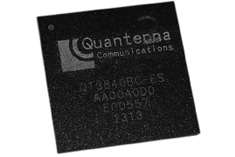(Phys.org) —Quantenna Communications has announced that it has plans for releasing a chipset that will be capable of delivering 10Gbps WiFi to/from routers, bridges and computers by sometime next year. The announcement comes as competition in the WiFi chip-set market has been heating up due to ever increasing demand. Current delivery speeds utilizing the standard 5GHz frequency bandwidth can handle just 1.3Gbps.
Improvements to WiFi are being driven by customer demand as users want to make use of ever more data intensive applications such as on-demand video, using a growing list of devices. In response, delivery standards have been evolving as governments allocate more bandwidth. The newest standard 802.11ac allows for multiple input/multiple output (MIMO) as well as multiple user (MU) chipsets. Chipmakers are using the new standard to develop chipsets that can send and receive data using multiple antennas on both the sending and receiving end, which allows for more data to be transmitted during the same time frame. The result should be devices able to move content faster than ever.
Currently, most chipsets send and receive three spatial transmission streams at the same time—they are based on what's known as 3x3 MIMO. To increase throughput, chipset makers increase the number of transmission streams. Quantenna has already produced a 4x4 MIMO chipset that is capable of offering up to 1.7Gbps throughput. Also, recently rival Broadcom delivered a six-stream chipset with data rates up to 3.2Gbps. Quantenna has now upped the ante by promising an 8x8 MIMO chipset that the company says will be able to deliver 10Gbps—as early as sometime next year. In its announcement, the company claimed that the new chipset will be backwards compatible with previous standards (a, b, g and n) and will also offer "adaptive beam forming" which is where the signal is analyzed on both ends to provide for a best path as well as noise reduction.
The new chipset will merge multiple 5GHz frequency channels to create one that is equal to a single 160MHz channel (as opposed to 80MHz offered by current routers). The company says the chipset should be useful in a variety of applications, ranging from enterprise networks to home applications. There is one exception however—Quantenna does not plan to make the new chipset available for use in mobile devices (phones or tablets) or for USB adaptor devices—that leaves routers, bridges and personal computers.
More information: www.quantenna.com/pressrelease-04_14_14.html
© 2014 Phys.org





















